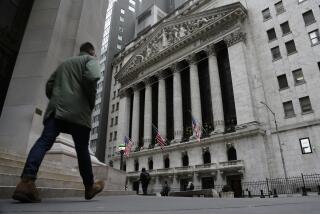Bonds Put You to Sleep? This May Awaken Your Interest
- Share via
This is a column about bonds. And having heard that, 99 out of 100 readers now will turn to another story in the paper. Because nobody cares about bonds anymore.
But if you’ve ever invested away from the crowd--or even just thought about it--there may be something here for you. As it turns out, some interesting people are singing the praises of bonds these days.
First, however, the bad news. The total return on the average U.S. government bond mutual fund has been just 34% over the last five years. The average U.S. stock fund, in contrast, has surged 89%. It doesn’t take a math scholar to realize that bonds in general have been a comparatively dumb bet.
What’s more, bonds used to be considered fairly stable investments. But in recent years, their week-to-week volatility has often exceeded stocks’, as interest rates have gyrated.
The rational investor thus looks at bonds and sees an investment that offers relatively modest annual yields of 5% to 8%, depending on the term and the type of bond (Treasury, corporate, municipal, etc.); jumps around a lot (in principal value); and is forever hostage to the whims of central bankers and the economy’s cycles, real and imagined.
The rational investor looks at stocks, on the other hand, and sees an investment whose long-term performance ultimately depends on its own fundamentals and which has returned more than 11% annually over the last 10 years, with only minor interruptions and with surprisingly low volatility.
Given all of that, who would buy bonds today? Naturally, some investment pros who have hated stocks forever will side with bonds--but their views have to be discounted appropriately.
A far more relevant new voice for bonds is that of John Templeton, the sage who founded the Templeton Funds group and who compiled a legendary record investing in “value” stocks worldwide between 1954 and 1992.
Now 84, Sir John has in recent months been extolling the virtues of owning bonds--specifically, longer-term U.S. Treasury bonds. In an interview with the New York Times in late April, Templeton said 30-year T-bonds, then yielding just over 7% (versus 6.98% as of Friday), represented a “very good” investment.
In stark contrast, he said that chances were “more than even” that the high-flying U.S. stock market won’t be any higher in two or three years than it is today.
*
Worries about stocks’ heights aren’t new, of course. People have been bad-mouthing the bull market throughout the 1990s, yet it has continued to climb as the economy has remained healthy and corporate earnings have boomed.
But lately even some of Wall Street’s biggest stock bulls have turned more cautious, as the market has rebounded dramatically from its early-spring slide.
Edward Kerschner, investment strategist at brokerage PaineWebber in New York and a longtime bull, wrote to clients on May 12 that the market, “while not extremely overvalued, certainly is no longer attractive” by his measures.
His major concern is corporate earnings growth, which he expects to slow over the next year. With the market already high-priced, Kerschner says, stocks are more likely to fall 10% from here than to rise 10%. So he is telling clients to keep no more than 50% of their portfolios at risk in stocks--and a full 40% earning interest in bonds.
But is that really practical for individual investors? Many would say no. For one thing, the younger you are and the longer your horizon, the greater the share of assets you can afford to have in stocks, regardless of how overpriced they may be in the short run.
Second, real people have real tax issues: Unless earned in a tax- deferred account or on a tax-free muni issue, bond interest is fully taxable as paid. Long-term gains in stocks, on the other hand, are taxed at the lower capital gains rate--which is a maximum 28% now and expected to be cut as part of the budget deal between President Clinton and Republican leaders.
Third, if what individual investors are looking for is a portfolio buffer in case the stock market plummets, many of them would just as soon keep the money in short-term “cash” accounts, such as money market mutual funds, which now yield about 5% on average. The difference between a super-safe 5% yield and a riskier 6% to 7% yield on longer-term bonds doesn’t seem worth the bother to many people.
All good arguments against bonds--that is, unless the bond market is on the verge of a wildly bullish move that would produce total returns (interest plus principal appreciation) approaching what stocks have earned recently.
Is that possible? A bullish move in bonds means just one thing: a major decline in long-term interest rates. Which is exactly what bonds’ biggest fans expect.
Dan Fuss, veteran bond fund manager at Loomis, Sayles & Co. in Boston, paints the scenario this way: In the 1990s, yields have already come down sharply on long-term bonds of many developing nations and on other high-risk issues (such as corporate junk bonds). Meanwhile, in absolute terms, yields have fallen less on U.S. Treasury bonds than on many competing bonds--even though U.S. inflation has been benign.
That has left “real” yields--meaning after-inflation yields--at extremely attractive levels on Treasury issues, Fuss says. If inflation stays around 3%, and a long-term Treasury bond yields about 7%, the real yield is about 4%.
For an investment that has no credit risk, that is unquestionably a lucrative return, Fuss says. John Templeton feels the same.
Moreover, Fuss says, “I think the secular forces [in the economy] are still for lower interest rates.” True, the Federal Reserve raised short-term rates in March and could do so again to cool the economy. But that just guarantees that inflation will be contained, Fuss says--which is ultimately bullish for long-term bond yields, because it removes the risk of accepting a fixed return only to see it eroded by rising inflation.
Templeton, in fact, believes that central-bank vigilance and global competitive pressures mean inflation is “less of a worry now than it was most of this century.”
The kicker, Fuss says, may be the shrinking U.S. budget deficit, and with it the Treasury’s shrinking need to issue new debt. Faced with a smaller supply of new bonds, investors worldwide who have been eager buyers of Treasury issues could turn absolutely voracious as they try to lock in returns--driving long-term U.S. yields down to 5% in the years ahead, Fuss says. (That is a number Templeton foresees as well.)
“The period of [the Treasury] paying up to get people into bonds is almost over,” Fuss predicts.
*
Sound too far-fetched? Many Wall Streeters think so. Most would agree that a global recession could quickly slash bond yields. But barring that (and recession seems highly unlikely soon) there are many good arguments against a fresh plunge in yields.
For example, inflation may well revive with a stronger global economy. Also, bond investors worldwide could panic when Germany and Japan eventually begin raising their short-term rates as their economies continue to recover.
In addition, some outside event--a tumbling dollar, for instance--could provoke foreign holders of U.S. bonds to dump them, sending yields soaring. And if market rates rise, not only would today’s bond buyers be stuck with lower yields, but their bonds’ principal values would erode accordingly.
Perhaps most important, if the issue for investors is stocks versus bonds, many pros look at it this way: In the absence of recession, if bond yields fall it will automatically be good for stocks too--and stocks are all people want to buy anyway.
That has certainly been true so far. But if Templeton is right that the odds favor disappointing returns on U.S. stocks for several years, after the tremendous returns of the last six, investors may look back on today’s 7% long-term bond yields as exactly the diversification element their stock-heavy portfolios needed.
(BEGIN TEXT OF INFOBOX / INFOGRAPHIC)
‘90s Yields: The Trend is Down
Despite periodic rebounds, bond yields have generally been trending lower worldwide in the 1990s, and the range between the highs and lows in each cycle has been narrowing. Yields on 10-year government bonds in Australia, the United States and Germany, quarterly closes and latest:
Australia: Friday: 7.52%
United States: 6.74%
Germany: 5.90%
Source: Bloomberg News
More to Read
Inside the business of entertainment
The Wide Shot brings you news, analysis and insights on everything from streaming wars to production — and what it all means for the future.
You may occasionally receive promotional content from the Los Angeles Times.










